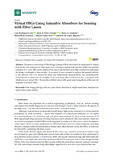Mostrar el registro sencillo del ítem
Virtual FBGs using saturable absorbers for sensing with fiber lasers
| dc.creator | Rodríguez Cobo, Luis | es_ES |
| dc.creator | Pérez Herrera, Rosa Ana | es_ES |
| dc.creator | Quintela, M. A. | es_ES |
| dc.creator | Ruiz Lombera, Rubén | es_ES |
| dc.creator | López-Amo Sáinz, Manuel | es_ES |
| dc.creator | López Higuera, José Miguel | es_ES |
| dc.date.accessioned | 2019-07-17T12:13:12Z | |
| dc.date.available | 2019-07-17T12:13:12Z | |
| dc.date.issued | 2018 | |
| dc.identifier.issn | 1424-8220 | |
| dc.identifier.uri | https://hdl.handle.net/2454/33612 | |
| dc.description.abstract | The spectral narrowing of Fiber Bragg Gratings (FBGs) introduced by unpumped Er-doped fiber (EDF) was analyzed for fiber lasers (FL). Owing to spatial hole burning (SHB), the spectral response of a virtual FBG can be employed for narrowing the band pass filter employed to determine the lasing wavelength of laser cavities. A common FL was mounted to analyze the spectral stability of the method, and a FL sensor for strain and temperature measurements was experimentally characterized to determine the stability of the narrowing effect achieved by the unpumped EDF, which acts as a virtual FBG. The results exhibited remarkably good narrowing effects of the spectral response of uniform FBGs. | en |
| dc.description.sponsorship | This research was funded by MINECO (Spain) project TEC 2016-76021-C2-R and FEDER funds. | en |
| dc.format.extent | 10 p. | |
| dc.format.mimetype | application/pdf | en |
| dc.language.iso | eng | en |
| dc.publisher | MDPI | en |
| dc.relation.ispartof | Sensors, 2018, 18, 3593 | en |
| dc.rights | © 2018 by the authors. Licensee MDPI, Basel, Switzerland. This article is an open access article distributed under the terms and conditions of the Creative Commons Attribution (CC BY) license. | en |
| dc.rights.uri | http://creativecommons.org/licenses/by/4.0/ | |
| dc.subject | Erbium doped fibers | en |
| dc.subject | Fiber bragg gratings | en |
| dc.subject | Fiber lasers | en |
| dc.subject | Fiber optics sensors | en |
| dc.subject | Single-mode laser | en |
| dc.subject | Temperature sensor | en |
| dc.title | Virtual FBGs using saturable absorbers for sensing with fiber lasers | en |
| dc.type | info:eu-repo/semantics/article | en |
| dc.type | Artículo / Artikulua | es |
| dc.contributor.department | Institute of Smart Cities - ISC | es_ES |
| dc.contributor.department | Ingeniería Eléctrica, Electrónica y de Comunicación | es_ES |
| dc.contributor.department | Ingeniaritza Elektrikoa, Elektronikoa eta Telekomunikazio Ingeniaritza | eu |
| dc.rights.accessRights | info:eu-repo/semantics/openAccess | en |
| dc.rights.accessRights | Acceso abierto / Sarbide irekia | es |
| dc.identifier.doi | 10.3390/s18113593 | |
| dc.relation.projectID | info:eu-repo/grantAgreement/ES/1PE/TEC2016-76021 | en |
| dc.relation.publisherversion | https://doi.org/10.3390/s18113593 | |
| dc.type.version | info:eu-repo/semantics/publishedVersion | en |
| dc.type.version | Versión publicada / Argitaratu den bertsioa | es |






